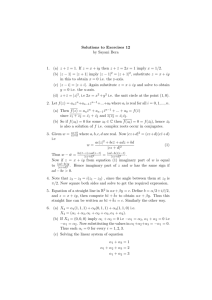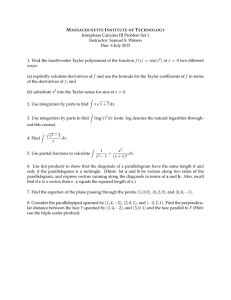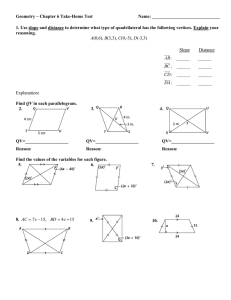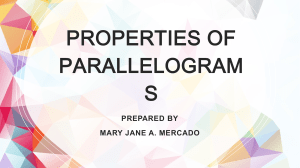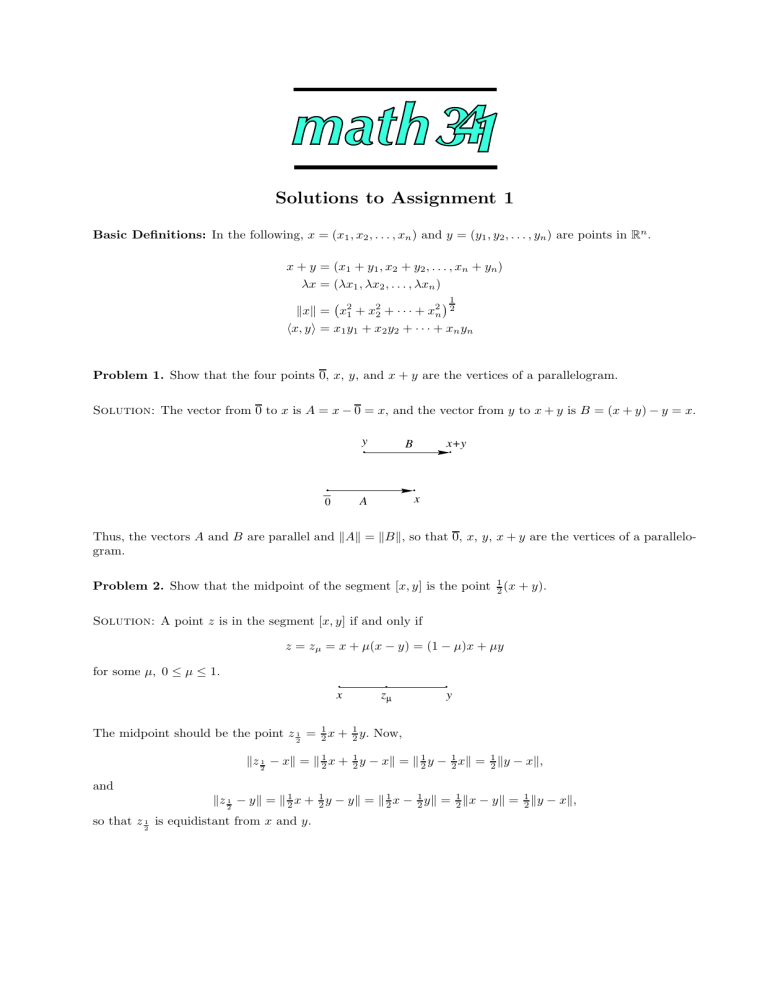
Solutions to Assignment 1 Basic Definitions: In the following, x = (x1 , x2 , . . . , xn ) and y = (y1 , y2 , . . . , yn ) are points in Rn . x + y = (x1 + y1 , x2 + y2 , . . . , xn + yn ) λx = (λx1 , λx2 , . . . , λxn ) 1 kxk = x21 + x22 + · · · + x2n 2 hx, yi = x1 y1 + x2 y2 + · · · + xn yn Problem 1. Show that the four points 0, x, y, and x + y are the vertices of a parallelogram. Solution: The vector from 0 to x is A = x − 0 = x, and the vector from y to x + y is B = (x + y) − y = x. y x A 0 x+y B Thus, the vectors A and B are parallel and kAk = kBk, so that 0, x, y, x + y are the vertices of a parallelogram. Problem 2. Show that the midpoint of the segment [x, y] is the point 12 (x + y). Solution: A point z is in the segment [x, y] if and only if z = zµ = x + µ(x − y) = (1 − µ)x + µy for some µ, 0 ≤ µ ≤ 1. x zµ y The midpoint should be the point z 21 = 12 x + 21 y. Now, kz 21 − xk = k 21 x + 21 y − xk = k 21 y − 12 xk = 12 ky − xk, and kz 21 − yk = k 21 x + 21 y − yk = k 21 x − 21 yk = 12 kx − yk = 12 ky − xk, so that z 21 is equidistant from x and y. Problem 3. Show that kx + yk2 = kxk2 + 2hx, yi + kyk2 . Solution: From the linearity and symmetry of the inner product we have kx + yk2 = hx + y, x + yi = hx, x + yi + hy, x + yi = hx, xi + hx, yi + hy, xi + hy, yi = hx, xi + 2hx, yi + hy, yi, and from the definition of the Euclidean norm, this gives kx + yk2 = kxk2 + 2hx, yi + kyk2 . Problem 4. Using vectors, prove that the medians of a triangle are concurrent. Solution: Given a triangle with vertices A, B, C ∈ Rn , let D ∈ Rn be the midpoint of the segment [B, C] and let Ga ∈ Rn be the point along the median AD which is 32 the distance from A to D. B D Ga A C We have Ga = A + 23 (D − A), and since D = 12 (B + C), then Ga = A + 2 3 · 21 (B + C) − 23 A = 31 A + 31 B + 13 C. If we define Gb and Gc similarly, then we see that Ga = Gb = Gc = 31 (A + B + C), so that the point 13 (A + B + C) lies on each of the three medians. Problem 5. Using vectors, prove that the line joining the midpoints of two sides of a triangle is parallel to the third side. Solution: Given a triangle with vertices A, B, C, let P and Q be the midpoints of the sides AB and BC, respectively. B P A Q C The vector Q − P is Q − P = 12 (B + C) − 21 (A + B) = 12 (C − A) and is parallel to the vector C − A, and kQ − P k = 12 kC − Ak. Thus, the line joining the midpoints of the two sides is parallel to the third side, and half its length. Problem 6. Using vectors, prove that the diagonals of a parallelogram bisect each other. Solution: Given a parallelogram with vertices 0, A, B, A + B, A A+B B 0 The midpoint of the diagonal [0, A + B] is 1 2 (A + B), while the midpoint of the diagonal [A, B] is A + 12 (B − A) = 21 (A + B), so that 12 (A + B), lies on both diagonals and is the midpoint of both diagonals. Problem 7. Using vectors, prove that the diagonals of a rhombus are perpendicular. Solution: If the parallelogram with vertices 0, A, B, A + B is a rhombus, then kAk = kBk, and the diagonals have the directions of A + B and A − B, and hA + B, A − Bi = kAk2 − hA, Bi + hB, Ai − kBk2 . Now, since kAk2 = kBk2 and hA, Bi = hB, Ai, then hA + B, A − Bi = 0, that is, the diagonals of the rhombus are perpendicular. Problem 8. Let ABCD be a quadrilateral. Show that the midpoints of the sides of ABCD form a parallelogram. (This is true even if ABCD is not planar). Solution: Give a quadrilateral ABCD let E, F, G, H be the midpoints of the sides BC, CD, DA, AB respectively. B F H A C E G D The vector from H to E is E − H = 21 (B + C) − 21 (A + B) = 12 (C − A), and the vector from G to F is F − G = 21 (C + D) − 12 (A + D) = 12 (C − A), that is, E − H = F − G, so the sides EH and F G are parallel and have the same length. Therefore, EF GH is a parallelogram. Problem 9. Prove the parallelogram law: The sum of the squares of the lengths of the four sides of a parallelogram is equal to the sum of the squares of the lengths of the diagonals. Solution: Given a parallelogram with vertices 0, A, B, A + B, A A+B B 0 the diagonals are A + B and A − B, so that kA + Bk2 = hA + B, A + Bi = kAk2 + 2hA, Bi + kBk2 and kA − Bk2 = hA − B, A − Bi = kAk2 − 2hA, Bi + kBk2 . Adding these two equations, we get the parallelogram law: kA + Bk2 + kA − Bk2 = 2(kAk2 + kBk2 ). Problem 10. Show that n lines separate the plane into parallel and no three pass through a common point. n2 + n + 2 regions if no two of these lines are 2 1+1+2 = 2, and 1 line does indeed separate the plane 2 into 2 regions, so the result holds for n = 1. Assuming the result is true for some n ≥ 1, if we add an (n + 1) st line to the collection of n lines in general position, so that again, no two lines are parallel and no three lines are concurrent, then this line intersects each of the others and is partitioned into n + 1 intervals. Each of these intervals splits an existing region into two regions, so the number of regions is now Solution: For n = 1, the expression has the value n2 + n + 2 n2 + n + 2 + 2(n + 1) (n + 1)2 + n + 1 + 2 +n+1= = 2 2 2 so the result is then true for n + 1. By the principle of mathematical induction, it is true for all n ≥ 1.
